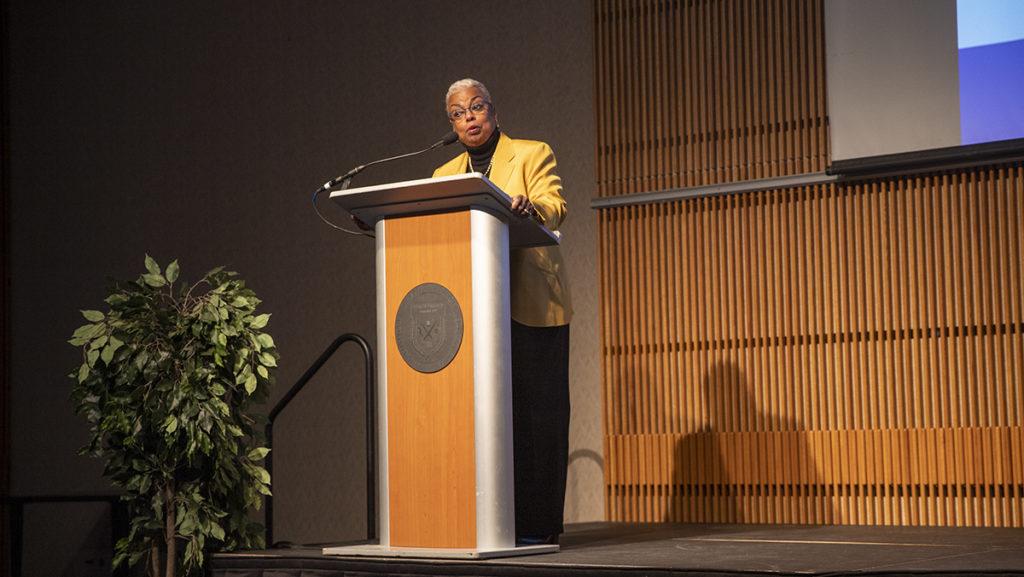Ithaca College President La Jerne Cornish and members of the President’s Cabinet gave updates to the campus community about enrollment, finances and student life at the State of the College gathering Oct. 18.
Around 100 members of the campus community attended the gathering in Emerson Suites, where Cornish spoke about how the 2022–23 academic year has been progressing so far. Cornish thanked the campus community for their work during the first half of the fall semester and said she hoped the college could build upon the momentum and energy created from Family Weekend and the Presidential Inauguration on Oct. 1.
“So many of our community members from current students to alumni shared with me how energized they felt after a weekend of connection and celebration,” Cornish said. “It is my sincere hope that we will build on and sustain this momentum as we move toward the close of another vibrant semester here in South Hill.”
Cornish said two more roles on the Cabinet need to be filled and that searches for a vice president of Marketing and Communications and a vice president for Philanthropy and Engagement will begin Nov. 1. She also said she will be traveling on the “Ithaca Together: Inaugural Tour” for the remainder of Fall 2022 into Spring 2023.
“As much as I treasure being immersed in the IC experience right here in South Hill, I have a responsibility as president to meet members of our community who reside far and wide and I am very much looking forward to sharing updates from South Hill with alumni, IC parents and families and other friends of the college,” Cornish said.
Enrollment
Laurie Koehler, vice president for Marketing and Enrollment Strategy, said that overall enrollment for Fall 2022 exceeded what the college has budgeted by close to 70 students. The college has a total of 5,054 students with 4,619 undergraduate students. The first-year class for Fall 2022 increased to 1,309 students from 1,163 in Fall 2021.
In Fall 2021, there were 4,818 undergraduate students enrolled at the college with a total of 5,239 students. In Fall 2020, there were 4,957 undergraduate students enrolled at the college with a total of 5,354 students. In Fall 2019, there were 5,852 undergraduate students with a total of 6,266 total students, and in Fall 2018 there were 6,101 undergraduate students with a total of 6,517 students.
Koehler said the Class of 2026 also saw a higher percentage of first-generation college students and a higher percentage of students of color.
She said a significant statistic for the college was the 3% increase in yield rate from Fall 2021 to Fall 2022. Yield rate is the number of students who enroll at the college out of the number of accepted students. The yield rate for Fall 2022 is 14% compared to 11% in Fall 2021 and 10% in Fall 2020. Koehler said the college’s yield rate outperformed other schools, whose yield rate declined on average by 0.6%.
“This did not happen by accident,” Koehler said. “Our yield increased as a result of very intentional, targeted efforts and [a] newly designed, clearer financial aid package and new digital to print communication campaign.”
She said the college also implemented Zoom appointments for accepted students with the Office of Student Financial Services to walk through a four-year financial forecast, had increased virtual engagement with students and held more on-campus visits.
Koehler said the third semester retention rate dropped one percentage point from 84.2% in Fall 2021 to 83.2% in Fall 2022. The third semester retention rate had increased following the significant decrease that occurred because of the pandemic, but the level has not increased to its pre-pandemic rate. In Fall 2015, the third semester retention rate was 85%, compared to 83% in 2016, 85% in 2017, 87% in 2018, 87% in 2019 and 77.1% in 2020.
“We also know that there are still lingering effects nationally that are affecting student retention and attrition related to the pandemic [and] related to the economic conditions in the country,” Koehler said. “So that’s something I’m paying close attention to. It is going to take us time to move the needle. You need to understand that this is hard work and infrastructure work and it takes time.”
Finances
Tim Downs, chief financial officer and vice president for Finance and Administration, provided updates about the budget and net assets at the college, as well as ongoing capital projects on campus.
Downs said that since the COVID-19 pandemic began, enrollment and revenue at the college has decreased. He said the college has sustained a breakeven over that time period but will be making a few changes over the coming years to adjust.
Downs said that in the coming years, the college is aiming for a more sustainable target of 1,400 first-year students, rather than its prior goal of 1,600 or 1,700, and a third semester retention rate of 90% by 2027.
“The smaller classes are going to graduate and we’re going to see ourselves build back up just like we did in Fall [2022], and we’re going to hit a steady state as we build our way back through this COVID area,” Downs said.
He said the college will continue to have some operational challenges in the short term before it resolves the deficits created because of COVID-19.
“So that’s going to rely on all of us to kind of lean into this, so we’re thinking about kind of where we need to be spending our money,” Downs said. “We need to make sure we’re thoughtful and we’re making sure we help our bottom lines minimize the deficits we have over the next few years. And then as we get to the steady state that will be our financial state in the future.”
He said that the first half of 2022 was a tough period for the college’s endowment, which dropped from $425.2 million in 2021 to $357.3 million in 2022 so far, but that the college is in a good position because it does not draw heavily from its endowment and has a strong short-term cash basis and short-term investments.
“This is what we’re going to be able to use over the next few years as we lean into these deficits, and we get back to our sustainable size and that will limit us from having to make those further reductions,” Downs said.
Downs also provided updates on projects happening on campus, like the renovations to the Dillingham Center that are now complete and the revamped entryway and stairs next to the Textor Ball that will be completed in the spring.
Academic Affairs
Provost Melanie Stein provided an update on academic affairs at the college, including upcoming college–wide curriculum revision and the three news deans at the college.
Stein said one goal of the Ithaca Forever strategic plan — the college’s five year strategic plan — is to support collaboration, interdisciplinarity, curricular flexibility and shared governance. She said the current curriculum at the college was developed when there were ample faculty resources but declining student enrollment, so the college needs to revise the curricula to ensure that it is properly aligned with its faculty resources.
“I’m talking about the strategic plan objective just to remind us that what we decided was that we needed to enable all IC students to explore wide-ranging subjects across the five schools and to construct or choose from curricular paths that match their goals and interests,” Stein said. “It’s about the students’ primarily curricular vision. It is about providing space and flexibility for exploration to ensure that we deliver on our promise about the benefits of our unique blend of programs.”
Stein said the process will take two years and involve multiple departments, including faculty and staff committees and administration in academic affairs.
Student Affairs and Campus Life
Bonnie Prunty, vice president for Student Affairs and Campus Life, gave updates on the recent partnership between student health services and Cayuga Health System (CHS), the JED campus initiative and student life on campus.
Prunty said the student health partnership has allowed for the college to offer high quality health care to students while figuring out ways to minimize the growing financial impacts and to benefit from the expertise that the CHS has in recruiting and retaining clinical staff — something she said the college has struggled with.
“This partnership provides the potential that, in the future, we could be looking at what kind of fiscal improvements we might be able to make to the building,” Prunty said. “It provides future expansion opportunities for the partnership. So we’re looking at other places like working in our PA school, and with our PT program where we might partner with CHS in the future.”
Prunty said that in the first month of the partnership, the student health center had 577 visits from students.
The college is currently halfway through its partnership with the JED campus initiative, which is run by the JED Foundation, a nonprofit organization that promotes emotional and mental health within young adults. Prunty said that because of the partnership, the college now has a tuition insurance program, a postvention team on campus and mental health screenings at the student health center.
Prunty said overall student engagement has increased on campus, following semesters where it was lower because of the pandemic. She said in the first block of the fall semester, student organizations had 425 events scheduled on Engage and 264 events already scheduled for the second block. She said the college is also trying out new spaces in the Campus Center, like a first-generation student lounge, a sensory room and a prayer and meditation space, to engage students.
“We will be kind of monitoring the use of those spaces and then working with students evaluating whether next year that’s the right use of those spaces or whether we should be doing something else,” Prunty said.
Editor’s Note: A previous version of the article stated that Ithaca College’s yield rate outperformed other colleges, whose yield rate declined on average by 6%. The other college’s rate actually declined by 0.6% on average.









